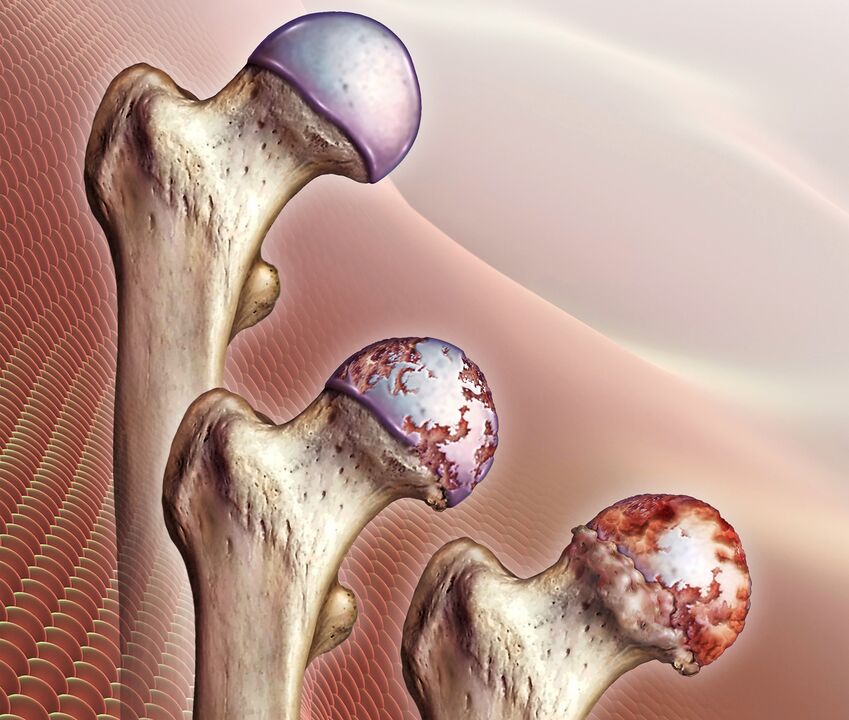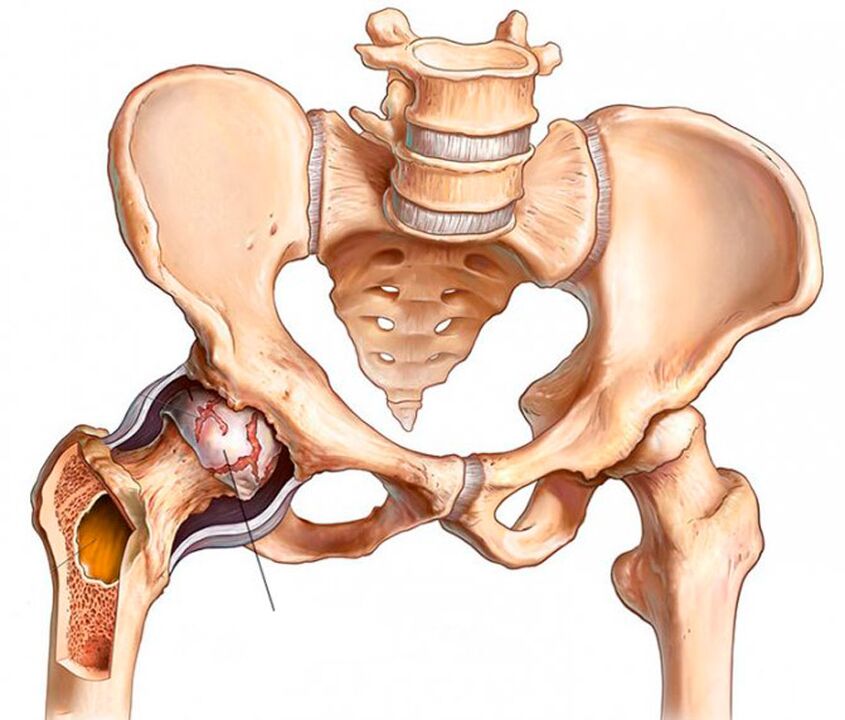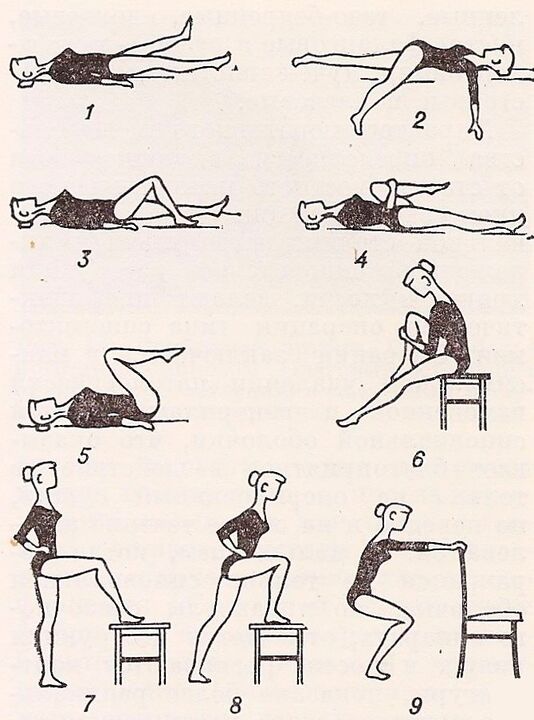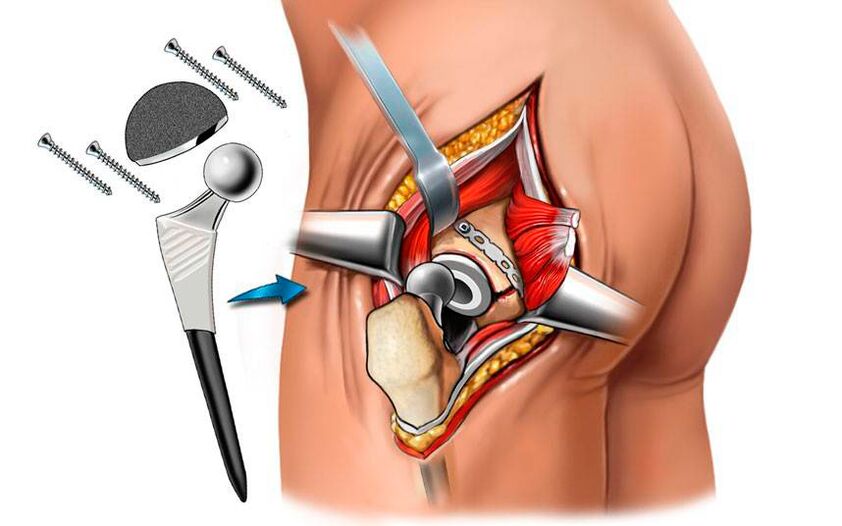Coxarthrosis of the hip joint is a degenerative-dystrophic process that occurs in the joint joint of the head of the femur and the pelvic acetabulum. The disease is more typical for middle-aged and elderly people, although it can also occur in young people, including children. Most often, its development is preceded by injuries, as well as a number of pathologies of an inflammatory and non-inflammatory nature, and pain and stiffness of movements become the main signs of the degenerative-dystrophic process in the hip joint. In its development, the disease goes through several stages, and if in the early stages it can be treated conservatively, then in the last stages, the treatment of coxarthrosis of the hip joints is effective only through surgery. Otherwise, the pathology will lead to severe disorders or even complete immobilization.
What is coxarthrosis of the hip joint and the mechanism of its development
Coxarthrosis, which is also called osteoarthritis and deforming arthrosis, is a complex disease of the hip joints (HJ), accompanied by progressive cartilage destruction. Over time, this leads to deformation of the surfaces of neighboring bones, as well as the formation of bone growths on them, called osteophytes.
The two hip joints are the largest joints in the body. Each of them forms the femur bone and the acetabulum of the pelvis. The head of the femur is located in the cup-shaped depression of the pelvic bone and moves freely in different directions. This joint structure allows flexion and flexion, adduction and abduction, and rotation of the thigh.
To prevent movement from causing discomfort, the surfaces of the bones that touch each other are covered with an elastic layer called hyaline cartilage. It is he who allows the head of the femur to easily slide into the acetabulum. Also, hyaline cartilage provides stabilization and cushioning of the hip joint during movement.
The entire joint is immersed in a kind of housing called the joint capsule. It contains a synovial membrane that synthesizes synovial fluid. It is the one that lubricates the surface of the cartilage, ensures the flow of water and nutrients into it, that is, it is responsible for maintaining the normal structure of the cartilage tissue.
Above the joint capsule is a group of femoral and pelvic muscles, with the help of which the joint moves. The hip joint is also surrounded by a group of ligaments that ensure the stability of its position within physiological limits.
Since the hip joint is exposed to heavy loads every day, it is prone to rapid wear and tear and injuries. The risk of such changes significantly increases the effect of a number of unfavorable factors that are practically inevitable in the modern world, but they will be discussed below. This explains the high prevalence of coxarthrosis.

As a result of the influence of negative factors, there is a violation of the production of synovial fluid. Gradually, its quantity decreases, and its qualitative composition also changes: it becomes viscous, thick and can no longer fully nourish the cartilage. This leads to acute nutritional deficiencies and progressive dehydration of the hyaline cartilage. As a result of such changes, the strength and elasticity of the cartilage tissue decreases, it peels, cracks and decreases in volume. All this prevents the smooth sliding of the head of the femur in the acetabulum of the pelvis, which leads to the appearance of signs of coxarthrosis of the hip.
Gradually, the inter-articular gap narrows, there is increased friction between the articular surfaces of the bones and the pressure of the bones on the hyaline cartilage increases. This leads to even greater injuries and wear and tear, which cannot but affect the biomechanics of the hip joint and human well-being.
As the pathological changes progress, the hyaline layer gradually disappears completely, which leads to the exposure of bone surfaces and a critical increase in the load on the bone joint. During movement, the femoral head is no longer covered by anything and rubs directly against the surface of the pelvic acetabulum. In addition to severely limiting mobility and causing excruciating pain, the bones are pressed together, flattening at the same time.

As the articular bones deform, bone growths (osteophytes) form on their surface. They can have sharp edges and seriously injure the surrounding muscles. This causes severe pain in the groin, legs and buttocks. Therefore, the patient unconsciously tries to spare the affected hip joint and avoid movements in it. Lack of adequate muscle load leads to their gradual atrophy, which further aggravates mobility problems. This results in lameness.
Reasons for development
Coxarthrosis of the hip joint can be primary or secondary. In the first case, no reasons for its development can be found, that is, the disease develops by itself without any reason. Secondary coxarthrosis is the result of a series of changes in the state of the musculoskeletal system or lifestyle characteristics, in particular:
- hip joint injuries, including bone fractures, dislocations, bruises, sprains or ruptures of surrounding ligaments, chronic microdamages, etc. ;
- exhausting physical work;
- sedentary lifestyle;
- obesity;
- chronic infectious processes in the body;
- rheumatoid arthritis, gout, tendonitis, bursitis;
- endocrine diseases, metabolic and hormonal disorders, including diabetes mellitus;
- congenital malformations of the hip joint (dislocation, dysplasia);
- aseptic necrosis of the femoral head;
- spine pathologies of various types;
- genetic predisposition;
- smoking addiction.
In the vast majority of cases, the development of coxarthrosis of the hip joint occurs due to inevitable age changes, and the presence of factors other than those listed only increases the risk of its occurrence and increases the rate of progression.
Symptoms and degrees
During coxarthrosis, there are 4 stages of development, of which 1 is the easiest. Initially, the disease may be asymptomatic or manifest as mild pain. They occur more often after strong physical exertion, a long walk or at the end of a hard day. In the first stages of the development of the disease, discomfort is usually attributed to fatigue and is considered the norm. Therefore, coxarthrosis of the hip joint is extremely rarely diagnosed in the 1st stage of development.
Visible signs of coxarthrosis begin to appear in the 2nd stage of its progression, when the joint space narrows almost in half, and the head of the femur is displaced and deformed. Moving to the 3rd stage, the pain becomes unbearable and can disturb a person even at night, they tend to radiate to the hips, lower legs, groin and buttocks. Since the joint space is already practically absent, and multiple osteophytes are formed on the bone surfaces, independent movement in such situations is impossible. Because of this, patients are forced to use a cane or crutches.

So, the main symptoms of coxarthrosis of the hip joint are:
- Limitations of movement - initially, patients may notice the appearance of difficulties in performing rotational movements of the leg, but over time they are joined by morning stiffness and swelling of the HJ. Because of them, a person needs a few minutes to warm up and, so to speak, walk in order to regain a normal range of motion. Gradually, it becomes increasingly difficult for the patient to perform leg movements.
- Characteristic crunching - occurs when walking, as well as bending or extending the hip joint. It is a consequence of bone surfaces rubbing against each other, and in coxarthrosis it is accompanied by sharp or dull pain.
- Pain syndrome - in the beginning, pain occurs after physical effort, and after a long rest, it subsides somewhat. An acute attack can be triggered by lifting weights or hypothermia, because coxarthrosis is often complicated by the addition of inflammation of the synovial membrane. As the disease progresses, the pain becomes more frequent, lasts longer and worsens.
- Femoral muscle spasm - is the result of pinched nerves and weakening of the ligamentous apparatus, so the spasm muscles hold compensatory to keep the head of the femur in the acetabulum. Also, muscle spasm can be caused by the addition of synovitis.
- Lameness - occurs in the last stages of the development of the disease, because the deformation of bone surfaces causes the appearance of flexor muscle contracture. Therefore, a person cannot fully straighten the leg and keep it in this position. Also, the patient may involuntarily limp to transfer weight to the healthy half of the body, as this helps reduce the intensity of pain.
- Shortening of the leg - observed in coxarthrosis of the 3rd degree. The leg on the side of the affected hip joint may be shortened by 1 cm or more as a result of narrowing of the joint space, decreased muscle tone, and flattening of the femoral head.
At the same time, degenerative-dystrophic changes can be observed in one or both hip joints. Accordingly, characteristic symptoms will be observed either on one side or on both at once, but in the latter case their severity on the left and right sides may differ.
Diagnostics
The doctor may suspect the presence of coxarthrosis of the hip joint based on the patient's complaints, external examination and results of functional tests. Be sure to measure the length of the legs during the visual inspection. For this, the patient is asked to stand up and straighten his legs as much as possible. The measurement is taken between the front axis of the pelvic bones and any bony structure of the knee, ankle or heel. But if both hip joints are simultaneously affected by coxarthrosis, the data obtained will not be informative.
But since the symptoms typical of coxarthrosis can accompany a number of other inflammatory and non-inflammatory diseases, instrumental examination methods are mandatory for the patient to accurately diagnose the pathology. It can be:
- CT or X-ray of the hip joint - images show destructive changes in it, narrowing of the joint space, formation of osteophytes and deformation of bone surfaces;
- MRI is the most informative examination method that allows you to accurately assess the nature of changes in cartilage structures, ligaments and the nature of blood circulation in the hip area.

Patients are also given laboratory tests to assess their general health and detect diseases that can cause coxarthrosis. That:
- UAC and OAM;
- blood chemistry;
- rheumatic tests;
- hip joint puncture with biochemical study.
The task of diagnosis is to distinguish coxarthrosis of the hip from gonarthrosis (damage to the knee joint), as well as radicular syndrome that occurs with osteochondrosis, as well as protrusion and herniation of intervertebral discs. Also, the symptoms of coxarthrosis can resemble the manifestations of trochanteric bursitis and the atypical course of ankylosing spondylitis, which requires a complete examination to reveal the true causes of pain and mobility limitations.
Conservative treatment
Conservative treatment of coxarthrosis of the hip is effective only in the initial stages of the disease. It is chosen for each patient individually and may include a whole range of different methods, each of which will complement the others. Therefore, as part of the treatment of coxarthrosis of the hip joint, patients can be prescribed:
- drug therapy;
- exercise therapy;
- physiotherapy;
- plasmolifting.
In order for conservative treatment to be effective, patients must eliminate the action of a number of factors that contribute to the occurrence of coxarthrosis of the hip. If you are overweight, it is very important to reduce it as much as possible. This will reduce the load on the affected joint and the risk of progression of the degenerative-dystrophic process.

You should also quit smoking and normalize your physical activity, avoid overexertion, but don't sit all the time. In order to prevent further destruction of the hip joint, it is recommended to wear special bandages and orthoses. They provide secure fixation of the joint and support it during movement.
Treatment
The nature of drug therapy is chosen strictly individually. In most cases, patients are prescribed:
- NSAIDs - drugs that simultaneously have an analgesic and anti-inflammatory effect (available in the form of tablets, injections and topical agents);
- corticosteroids - drugs with a strong anti-inflammatory effect, which are prescribed if NSAIDs do not have a pronounced effect;
- chondroprotectors - contribute to the activation of cartilage tissue regeneration, but their effectiveness has not been proven;
- muscle relaxants - drugs that reduce muscle tone and remove spasms, which is necessary for spasms of certain muscles or groups against the background of severe pain;
- preparations for improving blood circulation - they are most often used in the form of solutions for injections and help to improve the trophism of the tissue surrounding the joint;
- group B vitamins - have been shown to normalize the transmission of nerve impulses, which is especially important when nerves are compressed by deformed bone structures.
In case of acute pain that cannot be relieved by tablets, patients can be given intra-articular or peri-articular blocks. They are performed exclusively by qualified health workers in a health facility and involve the introduction of anesthetic solutions with corticosteroids into the joint cavity or the area directly around it.
exercise therapy
Therapeutic exercise is an effective method of solving the reduction of muscle tone and limitation of mobility. Thanks to a properly selected set of exercises, it is possible to increase the range of motion and reduce the intensity of pain. They also prevent muscle atrophy and help relieve spasms if coxarthrosis is accompanied by pinching of nerve fibers, which reflexively leads to spasms of certain muscles.
Exercise classes can improve blood circulation in the area of the degenerative-dystrophic process. Because of this, the quality of trophism of the diseased joint increases and accelerates the course of regenerative processes.

A specialist should individually develop a set of exercises for each patient. It takes into account not only the degree of destruction of the hip joint, but also the level of the patient's physical development.
Physiotherapy
Physiotherapy procedures and massage have an anti-inflammatory, analgesic, toning, anti-edematous effect. In addition, they help to maintain the normal tone of the leg muscles, preventing their atone and atrophy.
For coxarthrosis of the hip joint, courses of 10-15 procedures are prescribed:
- ultrasound therapy;
- magnetotherapy;
- laser therapy;
- electrophoresis;
- ultraphonophoresis;
- UHF;
- paraffin treatment.
Also, mud therapy is offered to many patients. Such procedures have a positive effect only in the 1st stage of development of coxarthrosis of the hip joint or during rehabilitation after surgical treatment. Thanks to the therapeutic mud, it is possible to achieve an improvement in the quality of blood circulation and speed up the recovery of the motor skills of the affected joint.
Plasmolifting
Plasmolifting or PRP therapy is a procedure that involves the introduction of plasma rich in platelets from the patient's own blood into the cavity of the hip joint. This allows you to activate the processes of restoration of hyaline cartilage.
But, according to some scientists, such a procedure can cause the formation of malignant tumors. This point of view is based on the fact that plasmolifting stimulates the creation of a large number of stem cells, whose effect on the body has not yet been fully studied.
Surgical treatment of coxarthrosis of the hip joint
Despite the significant discomfort in the hip joint, many seek medical help too late, when the pathological changes in the joint reach 3 or even 4 degrees of severity, and the functionality is irreversibly exhausted.
With advanced pathology, surgery is a necessary measure. Only timely surgical intervention will help restore normal mobility and save the patient from excruciating pain, that is, achieve a significant improvement in the quality of human life. No drugs or physiotherapeutic procedures can restore badly damaged cartilage. At best, painful intra-articular injections and medication can reduce the pain. But it will be a temporary phenomenon, after which the pain will return again with the same or even greater force.
Indications for hip surgery are:
- disappearance of the interarticular space;
- persistent pain in the hip joint, which cannot be relieved;
- critical mobility disorders;
- hip fracture.
Depending on the severity of joint destruction and bone deformity, patients can be offered different types of surgical treatment, namely:
- arthrodesis;
- endoprosthesis;
- osteotomy.
Arthrodesis
Arthrodesis is an affordable operation that involves strong fixation of joint bones with metal plates. The result is complete immobilization of the joint. Therefore, with the help of arthrodesis, it is possible to correct only the supporting function of the leg, remove the pain, but there is no need to talk about restoring mobility or significantly improving the quality of life.
Endoprosthetics
Endoprosthetics with arthroplasty is the only way to radically solve the problem of coxarthrosis of the hip joint while restoring all its functions and motor abilities. This is a high-tech method for solving the problem of coxarthrosis, which allows you to completely forget about it for 15-30 years, as well as about pain and movement restrictions. Thanks to the use of modern endoprostheses, it is possible to achieve complete restoration of motor functions and enable the patient to lead a normal life.
The operation involves resection of the head of the femur and part of its neck. Surgical preparation of the acetabular bed is also carried out, which includes removal of osteophytes, alignment of its surface and resection of tissue that has undergone necrosis. Endoprosthetics can be used even for the treatment of elderly patients with coxarthrosis of the hip.

The operation is performed under general anesthesia and lasts about an hour. Depending on the severity of the degenerative-dystrophic process, the operation can be performed by one of the following methods:
- superficial - includes grinding of the acetabulum and the head of the femur with further coating with smooth implants that replace the destroyed hyaline cartilage (the method is rarely used due to the possibility of inflammation in the periarticular tissues);
- unipolar - removal of the head of the femur and its replacement with an endoprosthesis (used when the cartilage is preserved on the surface of the acetabulum and only the head of the femur is destroyed);
- bipolar - similar to the previous technique, it differs only in the design of the used endoprosthesis, which has a lower coefficient of friction and ensures smoother movements in the joint bearing;
- total is the most effective and safest method for solving the problem of coxarthrosis of the hip joint, which includes complete resection of the femoral head with the capture of part of its neck, as well as the acetabular fossa and their replacement with full-fledged artificial joints.
Therefore, installation of different types of endoprostheses can be recommended to patients. Most hip replacements are manufactured in the USA and UK. Chemically and biologically inert metals are used for their production: alloys of cobalt, chromium, titanium. Ceramics are also often used. In most modern models, polymer cushions are additionally used, which enable natural cushioning, stabilization and gliding to artificial TBS.

After the operation, antibiotics are prescribed to prevent the development of infectious complications, and the stitches are removed after 10 days. The size of the postoperative scar is about 8 cm, and the patient is discharged from the clinic at the same time. Rehabilitation after endoprosthetics is simple, but still requires physiotherapy, massage and exercise therapy.
osteotomy
Osteotomy is a surgical intervention that is a temporary measure before the cardinal replacement of the hip joint with an artificial endoprosthesis. The essence of the operation is the alignment of the axis of the femur due to its intentional fracture. The resulting fragments are placed in the most suitable position, which slightly relieves the diseased joint. As a result, it is possible to temporarily reduce the intensity of pain and improve mobility.
Thus, coxarthrosis of the hip is a rather frightening disease that can completely deprive a person of the ability to move independently. It progresses over a long period of time, and its symptoms, especially in the early stages, are often perceived by patients as a normal condition after physical exertion. But this is precisely where the insidiousness of the disease lies, because only in the initial stage of development can it be treated non-surgically. But if the degenerative-dystrophic process has already completely destroyed the hyaline cartilage and led to the exposure of the bone surfaces, and even more to their flattening, only surgery can help the patient. Fortunately, the modern level of medicine and surgery, in particular, makes it possible to achieve a complete restoration of the normal condition of the hip joint and its functions.
































